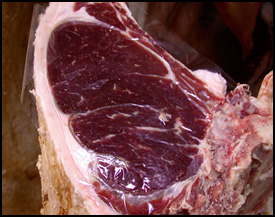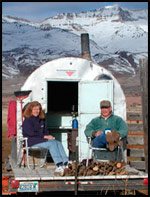MANAGEMENT...
Calm Down, Lighten Up
 Cattlemen can help prevent dark cutters.
Cattlemen can help prevent dark cutters.
In most situations, things go better when everyone remains calm. That's true for cattle, too, including those about to enter the food chain.
Excited cattle can become "dark cutters," lowering profit potential and causing beef demand challenges, says David O'Diam, brand extension manager for Certified Angus Beef LLC (CAB). Read more.

Ron Torell with his wife, Jackie
Cow Camp Chatter
Alternatives to supplementation.
Bovine supplements do not necessarily need to come from a block, tub, liquid or bag. There are many management practices that either reduce the nutrient demand of a cow or increase the nutrient supply without the use of traditional supplementation. Implementing these practices may not eliminate the need to supplement; however, they all help stockpile body condition. Let's review a few of these alternatives to supplementation. Read more.
Bloat Hazard:
Grazing Alfalfa In Fall 2010
After Labor Day weekend, many Montana ranchers begin sizing up their hay crop and pastures for fall and winter feed. Across Montana, substantial rain during 2010 has resulted in a supply of stored hay and standing grass — best described as “bodacious.” In many counties of central and eastern Montana, the growing season precipitation (April 1 through Sept. 1) matched or exceeded the long-term average annual precipitation.
Alfalfa and alfalfa-grass hayfields are widely utilized as a “hay-stockpile” system in Montana and the northern Great Plains. Alfalfa aftermath in late summer and autumn is a high-quality pasture for preconditioning calves, putting body condition on bred cows and flushing ewes. Alfalfa regrowth is a rich source of protein, energy, vitamins and minerals. However, due to the potential for pasture bloat, ranchers should always be cautious when grazing alfalfa-dominated hayfields. Fall grazing presents some specific challenges, particularly in 2010. Read more.

Kris Ringwall
Beef Talk
One bad steer spoils the lot.
The interest in age and source verification continues. The interest is real and the need is real.
As those who are involved in the process of selling beef know, once a commitment is made, that commitment needs to be honored. With the tight supplies of beef and the need to plan long term, kinks in the supply chain can make for some very long days.
Perhaps that is why the process of age and source verification continues to evolve and, much like fine wine, needs to age awhile. Read more.
Burning Invasive Juniper Trees Boosts
Perennial Grass Recovery
Controlling juniper trees by cutting them down and burning them where they fall keeps invasive cheatgrass at bay and allows native perennials to become re-established, according to findings by U.S. Department of Agriculture (USDA) scientists.
Agricultural Research Service (ARS) rangeland scientists Jon Bates and Tony Svejcar conducted a study at a site dominated by a stand of invasive western junipers to assess different management strategies after the junipers had been cut down. Click here to learn what they found.
Controlling Salt Cedar Leaf Beetle on Athel
A beetle used as a biological control of salt cedar is jumping to another tree, according to a Texas AgriLife Extension Service entomologist.Though one tree is hated and the other loved, the one thing they have in common is a small imported beetle that feeds on both, said Mark Muegge, AgriLife Extension entomologist at Fort Stockton.
Salt cedar is a shrub or small tree introduced into the U.S. more than a century ago for erosion control. Athel is a popular nonnative shade tree in southwestern Texas that's kin to salt cedar. According to Muegge, the beetles feed only on salt cedar and athel. If either of these plants are not present, the beetles die. Read more.
New Products
Industry affiliates provide a wide array of products and services to assist you on the farm and ranch. Here's an assortment of new products to hit the market recently.
• Organic certification listed
• Feed-grade inflammation management
• Organic technology for sludge treatment
• DNA profile for replacement heifers
• Explosion-proof lights for hazardous areas
Angus Advisor
Click here for September herd management tips from cattle experts across the nation. Advice separated by region.
[Click here to go to the top of the page.]




